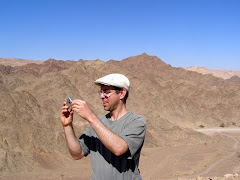 The bus ride from Istanbul to the border wasn't far and my long time friend Carolynn and I had our first extended conversation in a long time so the trip went by quickly. The border took a bit more than an hour as should be expected and then we were in Bulgaria and on the same bus towards Sofia.
The bus ride from Istanbul to the border wasn't far and my long time friend Carolynn and I had our first extended conversation in a long time so the trip went by quickly. The border took a bit more than an hour as should be expected and then we were in Bulgaria and on the same bus towards Sofia.The scenery had become a bit more hilly as we approached Bulgaria by bus from Istanbul and once we were on the other side of the border it was getting mountainous. On both side there were many fields of sunflowers. I had initially been attracted to Bulgaria when I heard about the Soviet encouragement of hiking as recreation and the claim of well mark trails was later confirmed. We, unfortunately, sailed through Plovdiv. People rave about it but we had only around five days and split that time between Sofia and the Rila Mountain area, including the city of Blagoevgrad.
We arrived Friday afternoon and went to a restaurant with live Bulgarian music and Bulgarian style cuisine that we enjoyed so much that we returned the next day. Saturday we hiked on the nearby Mt.
 Vitosha. This mountain provides a convenient escape for Sofia's residents and getting a bus ride there on Saturday morning meant competing for bus space with numerous locals. Our half day made it clear that there were many paths that could keep one exploring for many days. The first part of the hike was along a bolder covered river called "the Golden Bridges" which featured large bolders covering a stretch of the river longer than we managed to explore. We left the trail for a time and sometimes had to jump between the bolders.
Vitosha. This mountain provides a convenient escape for Sofia's residents and getting a bus ride there on Saturday morning meant competing for bus space with numerous locals. Our half day made it clear that there were many paths that could keep one exploring for many days. The first part of the hike was along a bolder covered river called "the Golden Bridges" which featured large bolders covering a stretch of the river longer than we managed to explore. We left the trail for a time and sometimes had to jump between the bolders. We rejoined the trail and hiked along the mountain and then down to Boyana Church, which is famous for frescoes considered forerunner of the Renaissance due to their realism and emotional expressiveness. Outside, it appeared as a quaint neighborhood Byzantine church with a peaceful forest setting most of the way down Mt. Vitosha.
 We spent the afternoon sightseeing in Sofia. We saw a Russian Orthodox Church, a Bulgarian Orthodox Church and then a Byzantine Basilica.
We spent the afternoon sightseeing in Sofia. We saw a Russian Orthodox Church, a Bulgarian Orthodox Church and then a Byzantine Basilica. The Bulgarian Orthodox Church, called St. Alexander Nevsky Cathedral is neo-Byzantine style cross domed basilica. with a central dome and barrel vaults. Among the paintings are realistic depictions of scriptural scenes as well as saints--all of which were well laid out such that the interior didn't feel noisy despite all wall space above about 6 feet being covered with some art work. With the choir singing for the religious service it was a satisfying scene to absorb.
The Byzantine Basilica was in great condition (undoubtedly after restoration) and there was a memorial plaque to Bulgaria's King Boris III, who had refused Nazi requests regarding Bulgaria's Jewish population. I talked to my new friend George about this king and was very impressed by his courage. George explained that Boris was invited to Germany during the war and "fell ill and died." Of course, Bulgarians believe that he was poisoned--a martyr to resistence to the Holocaust. The story was inspiring and I'm hoping to soon read about this King Boris.
 Sunday after church we traveled to Blagoevgrad and then to Rila Mountains where we engaged in a long hike with exceptional views and close up encounters with flocks of sheep. Wednesday morning we felt rested and refreshed as we alighted the train to Thessaloniki, taking with us memories of a brief introduction to a surprisingly fascinating country.
Sunday after church we traveled to Blagoevgrad and then to Rila Mountains where we engaged in a long hike with exceptional views and close up encounters with flocks of sheep. Wednesday morning we felt rested and refreshed as we alighted the train to Thessaloniki, taking with us memories of a brief introduction to a surprisingly fascinating country. 


